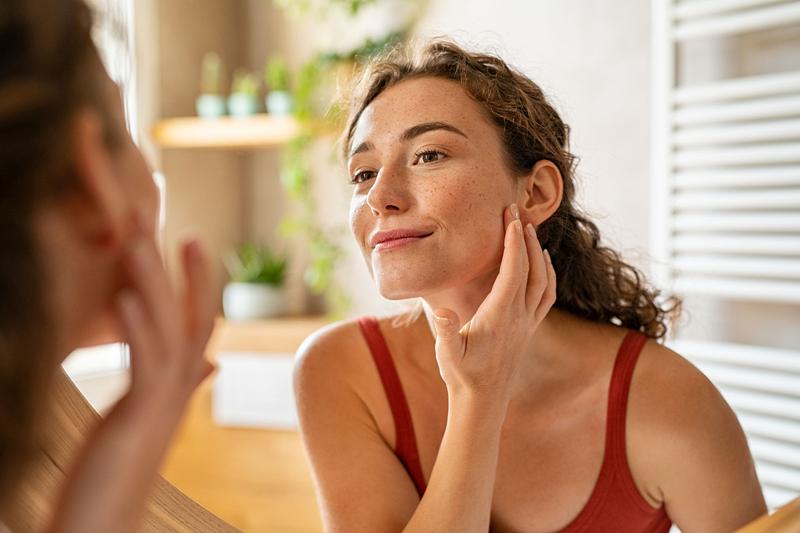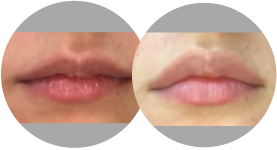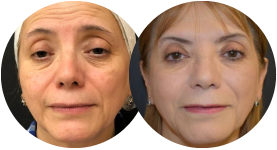Chemical Peels
Conveniently located to serve the areas of Rancho Cucamonga, CA

A chemical peel is a noninvasive treatment that involves the use of chemical agents to remove small layers of damaged skin to improve its overall appearance. (1) With this type of treatment, providers can target the epidermis (outermost layer of skin) and the dermis (the deeper layer). Chemical peels essentially clear the current layer of skin to make way for regeneration of new cells and the production of collagen. Once the current epidermal layer peels off, the cells are prompted to recreate themselves to heal, leading to clearer, softer, and more evenly textured skin. Whether you are experiencing acne flare ups and want to start anew, or you struggle with fine lines or hyperpigmentation, chemical peels can be formulated to fit your skin’s needs.
Dr. Patricia Guevara-Channell and her staff at Channell Wellness and Aesthetics in Rancho Cucamonga are here to help your skin become the best it can be. If you are interested in receiving a chemical peel, please fill out this form or contact us directly by calling (909) 483-1236.
Contents
- 1 Chemical Peel Science
- 2 Benefits of a Chemical Peel
- 3 Am I a Good Candidate for a Chemical Peel?
- 4 Personal Consultation
- 5 Preparation
- 6 Chemical Peel Process
- 7 Recovery and Results of a Chemical Peel
- 8 Complementary Treatment – Dermal Fillers
- 9 Cost of a Chemical Peel in Rancho Cucamonga
- 10 FAQ
- 11 References
Chemical Peel Science
Also referred to as chemexfoliation, chemical peels encourage the rejuvenation of skin by causing inflammation on the epidermis and dermis layers of the treated area. In 2016, they were the 3rd most popular cosmetic treatment, following Botox and dermal fillers. Often combined with other cosmetic treatments and procedures, chemical peels are versatile and effective for many different types of patients looking to improve the quality of the skin without surgery. Chemical peels are categorized into three different depths:
- Superficial (Light) Peel: penetrate the epidermis only
- Medium-Depth Peel: penetrate the epidermis and papillary dermis
- Deep Peel: controlled tissue injury penetration to the midrecticular dermis
Superficial peels last only a few weeks and have to be repeated if you want continued results. Medium-depth peels can last for several years, yet you are more likely to see side effects after receiving them. Deep peels have recently become less common, often replaced by more controlled and effective laser treatments. (1)
Superficial Peels
The most commonly used and effective chemical used in most superficial peels is glycolic acid. Made from sugar cane, it is an alpha-hydroxy acid (AHA) that exfoliates the skin by liquifying cells in the epidermis. The process breaks collagen and keratin molecule bonds, resulting in a “white frost” that forms atop the skin. This is what leads to the peeling, and then you are left with smooth, supple skin. For people with slight to moderate hyperpigmentation, fine lines, and scarring, a superficial peel can be very beneficial. It actively exfoliates the skin without causing much downtime for the patient. (1)
Medium-Depth Peels
A medium-depth chemical peel penetrates deeper into the skin than a superficial peel, leading to longer-lasting results. They often remove the full thickness of your epidermis in order to promote regeneration. This is usually done with a mixture of trichloroacetic acid (TCA) and glycolic acid. With medium-depth peels, less time is often necessary for the acid to penetrate the papillary dermis since the strength of the chemicals is much stronger than in a superficial peel.
Patients that receive this type of peel often are given ibuprofen or some other type of NSAID before the treatment as there is the potential for some minimal discomfort. This also helps with post-operative swelling that may occur. (2)
Deep Peels
This type of peel is meant for patients with moderate to severe sun spots, hyperpigmentation, and fine lines or wrinkles. The chemicals used for deep peeling are most commonly highly concentrated TCA or what is referred to as the phenol peel. Phenol peels are considered more consistent than peels using only TCA for deep peeling. They provide even chemexfoliation into the deeper layer of the face to provide more dramatic and longer-lasting results. These peels often require numbing or sedation to keep the patient comfortable. (1)
All types of chemical peels can be customized to the patient’s skin type. The chemical mixture of acids used can be changed depending on what issues you are trying to address and your skin’s sensitivity level. We will discuss all possibilities in your personal consultation.
Benefits of a Chemical Peel
There are plenty of benefits to receiving a chemical peel. They:
- Increase overall glow of the skin
- Restore tone and even the texture of the face
- Reduce the look of fine lines
- May reduce the appearance of large pores
- May be used to remove precancerous sun damaged skin
This minimally to moderately invasive treatment can be used for these specific reasons, or can also be utilized for simple refreshing for patients who want a new start to their skin.
Am I a Good Candidate for a Chemical Peel?
In order to determine the correct and most effective chemical peel treatment, Dr. Guevara-Channell will examine your skin. There are multiple combinations and acid types used for this treatment, and her experience and knowledge will guide her decision. Here are some symptoms potential candidates could treat with a chemical peel:
- Subtle fine lines around the eyes and mouth
- Pigmentation irregularities
- Recurring acne or milia on the face
- Uneven skin texture or tone
- Sun spots and acne scarring
Personal Consultation
During your private consultation with Dr. Guevara-Channell, she will ask about your medical history and anticipated results of the chemical peel to determine if the treatment is right for you. Common questions include how you heal, if you scar easily, and whether you have had previous resurfacing treatments or facial procedures. She will also ask if you have a history of cold sores, as some of the acids used can prompt recurrence.
Which Peel Will Suit My Needs?
Explaining each type of peel in great detail, she makes sure you are fully aware of what the treatment can do for you. She will answer any questions you have about the entire process, from the treatment plan to aftercare. If a chemical peel will not fit your needs, Dr. Guevara-Channell may suggest other more suitable cosmetic options.
Preparation
Before your chemical peel, you may be given certain topical products to use before and after your treatment to encourage healing and consistent results. This could be topical retinoids or a “prepeel” solution that will help prepare your skin for the abrasion. If the skin is prepped correctly, patients receive a more even and effective peel, elongating your initial results and assuring they meet your expectations. (2) You should protect your skin from direct sun exposure for at least 2 weeks before your treatment by wearing UVA and UVB blocking sunscreen. The morning before your treatment, cleanse your face with soap that will not leave a residue, so the chemicals have a clear layer of skin to penetrate. (3)
Chemical Peel Process
Dr. Guevara-Channell prepares the peel to ensure the chemical makeup is precise. As you are reclined in a comfortable position, she will apply acetone to the treatment area to remove any leftover makeup, oil, or debris. Then Dr. Guevara-Channell will apply the peel with a brush, cotton applicator, or gauze swap depending on the type of peel. She will apply it in even layers using moderate pressure, carefully avoiding overlapping. Once the first pass is finished, she may continue to perform even application if necessary. Then the solution is neutralized and removed, and the skin is gently cleansed. The whole procedure typically takes anywhere from 30 to 90 minutes depending on the peel’s depth. (3)
Recovery and Results of a Chemical Peel

Your skin will be irritated and mildly sore after your treatment. For superficial peels, this typically lasts for 1 to 3 days. Medium and deep peels result in longer healing times, usually 5 to 10 days. You will experience tightness, then eventually the layer of skin affected by the chemicals will begin to slowly peel off. You are advised not to scratch or physically peel the skin yourself, and to use a recommended gentle cleanser and moisturizer.
Dr. Guevara-Channell will inform you of any post-treatment steps to take to prevent any complications, including the possibility of hyperpigmentation. She will make sure you are prepared so you can fully enjoy your beautiful new skin!
After the affected skin peels, you will be left with smooth new skin. It may remain a reddish hue until your epidermis fully regenerates, but you should notice changes in texture and pigmentation right away. To maintain your results, you will have to continue to wear SPF at all times to protect and prevent future damage.
Complementary Treatment – Dermal Fillers
Dermal Fillers
This popular cosmetic treatment is commonly used to add volume to the face. Dermal fillers are soft tissue fillers that are injected into the face to reduce the appearance of wrinkles, hollowness, and to add structure. This treatment is minimally invasive and, like chemical peels, a straightforward in-office procedure. Dr. Guevara-Channell numbs the treatment area, then with light and even injections, addresses the designated sections of skin. The filler works instantly in reducing the look of wrinkles and the procedure usually takes around 30 minutes.
Cost of a Chemical Peel in Rancho Cucamonga
The complete cost of your chemical peel treatment depends on the acid type, duration, and depth of the procedure. We will provide a complete price breakdown during your consultation. To schedule your appointment at Channell Wellness & Aesthetics, call us at (909) 483-1236 or fill out this form.
Find out more about our other services on our blog.
FAQ
How often should I receive chemical peels to keep my results?
If your chemical peel is superficial, you might have to schedule another one in the future to achieve your desired results. Medium-depth peels can result in longer-lasting effects, but can also be repeated once your skin has fully healed. Deep peels have extremely long-lasting results, usually visible for years afterward.
Can I get the same results with an at-home chemical peel?
Though they are convenient, at-home treatments, especially ones that involve strong chemicals, can be dangerous and lead to complications. It is always better to seek a professional service, and your results will likely be more comprehensive and longer-lasting if a licensed medical professional performs the treatment.
References
- Soleymani T, Lanoue J, Rahman Z. A Practical Approach to Chemical Peels: A Review of Fundamentals and Step-by-step Algorithmic Protocol for Treatment. The Journal of clinical and aesthetic dermatology. 2018;11(8):21-28. Accessed November 6, 2023. https://www.ncbi.nlm.nih.gov/pmc/articles/PMC6122508/
- Rendon MI, Berson DS, Cohen JL, Roberts WE, Starker I, Wang B. Evidence and considerations in the application of chemical peels in skin disorders and aesthetic resurfacing. The Journal of clinical and aesthetic dermatology. 2010;3(7):32-43. Accessed November 7, 2023. https://www.ncbi.nlm.nih.gov/pmc/articles/PMC2921757/
- O’Connor AA, Lowe PM, Shumack S, Lim AC. Chemical peels: A Review of Current Practice. Australasian Journal of Dermatology. 2017;59(3):171-181. doi:https://doi.org/10.1111/ajd.12715






